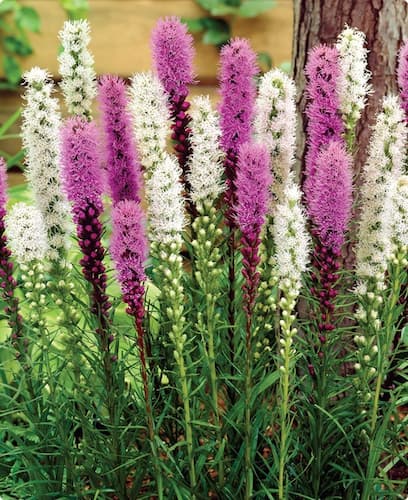How to Grow Gayfeather Flower Plants

About Growing Gayfeather Plants in Your Home Flower Garden
Perennial Gayfeather flowers are members of the Aster family. It is a hardy, drought-tolerant plant. Their nectar-rich flowers will attract butterflies to your yard. Gayfeather plants are native to the Eastern U.S. They put on a really showy display. If you are not yet growing gayfeather flowers, what are you waiting for!?
The Gayfeather plant itself grows to only about 2 – 3 feet in height. Their tall flower spikes will tower up to 6 feet.
Flowers bloom on the stem, opening from the top down. Flowers will bloom in the second year. The flowers are aromatic Include them in potpourris.
Due to their height, they are not good candidates for containers or flowerpots.
If you are looking to save the seeds, be on the lookout for birds. They will eat the ripening seeds.
Gayfeather Plant Specifications
Flower Colors: Lavender, Pink, purple, and white.
Flowers Bloom: Late summer to early fall.
Plant Height: 4 to 6 feet tall.
Light Requirements: Full sunlight to partial shade.
Ideal Soil pH: 5.5 – 7.0.
Hardiness Zone: 3 – 9.
Toxicity: Non-toxic.
Deer Resistant?: Yes. Deer usually avoid them due to the plant’s bitter taste and strong scent.
Native To: All 45 species are native to North America.
Plant Type: Perennial.
Botanical Name: Liatris Spicata.
Other Names: Blazing Star, Dense Blazing Star, Liatris
Is Gayfeather Edible?
NO!!
While gayfeather plants and flowers are not toxic, they have a bitter taste and strong scent. As a result, we found no reference to eating this plant.
Medicinal Applications for Perennial Gayfeather Plants
Gayfeather plants have a variety of medicinal uses. Among the medicinal uses (current and past) are:
- Use Gayfeather as an anti-bacterial agent.
- It treats measles and smallpox.
- Eases headaches and fever.
- It has been used to treat arthritis.
- The plant has anti-blood clotting properties.
- Use it as an expectorant.
Light Requrirements
Gayfeather’s natural habitat is open fields and prairies. So, the plants grow best in full sunlight. Give them six to eight hours or more of full sun.
They also grow in light, partial shade. However, increasing amounts of shade, results in smaller and fewer blooms.
Perennial Gayfeather Flowers Propagation
Gayfeather plants are grown from seeds. They can be directly seeded into your flower garden, or started indoors for transplanting later. Sow Gayfeather seeds 6 – 8 weeks before the last frost in your area. Cover seeds lightly with 1/8″ to 1/4″ of fine garden or seed starting soil.
Seeds are slow to germinate. If planted outdoors, the planting site should be well-marked.
Ideal plant spacing is 8″ -12″. Thin or transplant seedlings, if needed, when they reach 2″-3″.
Plants can also be propagated by tuberous roots or crowns. Dig up, divide, and re-plant tuberous roots every few years, to avoid over-crowding, and maximize plant growth and bloom.
The plants look their best in small groups. Moreover, if you can keep the colors separate prior to planting, you can create an eye-catching color pattern.
Days to Germination: 20 – 45 days.
How to Grow Gayfeather Flower Plants
Gayfeather plants grow best in full sun. They will tolerate a little light shade.
Grow plants in rich, well-draining soil. For the best performance, grow them in light, loose soils. Almost any soil is okay, except heavy clay soil that retains a lot of moisture.
Plants are drought tolerant. Water them only during extended periods of drought.
The plants do not do well, in soggy soils in winter. The roots rot.
Keep the plants well-weeded when they are still small.
Fertilize after the blooming period, with a general-purpose fertilizer.
For a nearly maintenance-free garden, add mulch around plants.
After a few years, the plants will become overcrowded. Dig up tuberous roots, separate and replant them. If you have extras, give some to your gardening friends!
Pruning Gayfeather Plants
Gayfeather flowers do not usually require pruning.
Insects and Plant Disease
Insect problems are uncommon.
Mildew diseases can occur, especially in areas of low sunlight or poor air circulation.
And, as previously mentioned, the roots can rot in extended periods of soggy soil. Planting them in a slightly elevated location helps to avoid this potential problem.
Also see: Plant Problems – Identify the causes and find the cures.
Overwintering Perennial Gayfeather Flowers
After the frost in the Fall has killed the plant for the season, cut the entire plant back to near the ground. In colder regions of the country, apply a layer of mulch to protect the roots.
If you want to feed your winter birds, leave the entire plant untouched, including the seed-laden flower stalk. Your backyard birds will thank you.
Related Articles
Also, people who read this article will like:
See more Perennial flowers.
Please support our site. Shop for:
- rmmatthews100@hotmail.com
- 585-721-6528
- Rochester, NY
©1999-2024 GardenersNet.Com, All Rights Reserved

